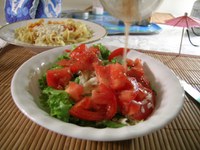Prairie Fare: Is It Time for an Oil Change in Your Kitchen?
(Click an image below to view a high-resolution image that can be downloaded)
By Julie Garden-Robinson, Food and Nutrition Specialist
NDSU Extension Service
Have you ever been startled by the unpleasant aroma of a previously opened container of oil or solid shortening?
I have a recipe that works best with a particular type of solid shortening. I hadn’t made the recipe for several months, so I reached into the cupboard and pulled out the container. When I opened the lid, I think my hair blew back. I turned my head to escape the odor.
Well, my hair really didn’t move, but I replaced the lid and walked straight to the trash can and threw it away. Even though I bought the smallest container of shortening I could find, I still didn’t use it before it became rancid. While rancid fat does not cause foodborne illness, some researchers have noted that eating rancid fat may cause chemical changes in our body that could promote chronic disease.
Rancidity is the natural spoilage of fats or oils due to changes in the chemical structure of the fat. Exposure to light, warm temperatures and oxygen can promote the rancidity process. If you deep-fry foods, be aware that moisture in the food and added salt can promote rancidity, too.
While most of us know that oils usually are considered more healthful than solid fats, oils tend to become rancid more quickly than solid fats. Plant-based fats such as canola, corn, olive, peanut and sunflower oil are more unsaturated than animal-based fats such as lard and butter.
Oils provide essential fatty acids (the type our bodies can’t make) and also vitamin E. We need essential fatty acids found in oils to help regulate our body’s biological functions and as part of our cell membranes. Vitamin E acts as an antioxidant that helps protect our cells, tissues and organs.
Because fats and oils are concentrated sources of calories, we have been cautioned to limit them to avoid excessive calorie intake. On a typical 2,000-calorie-a-day diet, the recommendation is about 5 teaspoons per day contained in foods. One teaspoon of oil has about 40 calories.
Many oils have distinct flavors and properties that make them tasty additions in your cooking. For heart health, nutrition experts recommend replacing solid fats with oils. Some shortenings are high in trans fats, which are formed when oils are hydrogenated to form solid fats. We need to minimize trans fats in our diet.
When incorporating fats, oils and foods high in fat in your diet, keep these tips from nutrition experts in mind:
- Use oils containing monounsaturated fat such as olive, canola, peanut and sesame oil instead of oils high in saturated fat such as coconut and palm oil.
- Try oils high in polyunsaturated fats such as corn, soybean, safflower, sunflower and cottonseed oils instead of coconut oil, palm oil or hydrogenated vegetable fats.
- Use liquid oils in place of butter, lard or hardened vegetable shortening. On average, use about 3/4 cup of oil for every cup of shortening.
- Enjoy foods high in unsaturated fats (omega-3 fats) such as fatty fish (salmon, mackerel and tuna) regularly.
- Incorporate foods high in polyunsaturated and monounsaturated fats such as avocados, nuts and olive oil into your recipes.
Choose healthful oils and be sure to buy what you will use in a reasonable amount of time. Store the oils in a cool, dark, dry place away from heat sources, such as near your stove.
Unopened containers of oil usually last about one to two years on the shelf, depending on the type of oil. Opened oil lasts anywhere from a few months to a year on the shelf. Storing oil in the refrigerator may extend its storage life.
Here’s a recipe that allows you to put on your chef hat and create your own salad dressing. Many store-bought salad dressings are high in sodium, so creating your own can help you trim sodium from your recipes.
Create a Salad Dressing
1 c. salad oil (your choice)
1/3 c. acid, such as red wine vinegar
1 tsp. garlic powder
1 tsp. onion powder
1/2 tsp. salt (or less, to taste)
1/2 teaspoon black pepper
Pinch of sugar (optional)
Put all ingredients into an airtight container such as a glass jar. Secure the lid and shake until ingredients are combined. Store salad dressing in the refrigerator. On average, 1 tablespoon of this recipe will have about 100 calories, 11 grams (g) fat, 0 g carbohydrate, 0 g fiber and 60 milligrams sodium.
Make this recipe your own signature recipe by substituting different ingredients that you have on hand.
- Oil: Try canola or olive oil. They have different flavors, but they both provide healthful monounsaturated fats. Canola oil costs much less and will make your homemade salad dressing a bargain, compared with store-bought salad dressings.
- Acid: Try different flavors of vinegar, such as balsamic vinegar, or try fruit juice. With fruit juices, you can use more acid and less oil, making a lower-fat salad dressing.
- Seasonings: Try any herbs or spices, salt, pepper or chopped vegetables (such as onions or peppers). Add some mustard if you like.
(Julie Garden-Robinson, Ph.D., R.D., L.R.D., is a North Dakota State University Extension Service food and nutrition specialist and professor in the Department of Health, Nutrition and Exercise Sciences.)
NDSU Agriculture Communication - April 20, 2017
| Source: | Julie Garden-Robinson, 701-231-7187, julie.garden-robinson@ndsu.edu |
|---|---|
| Editor: | Ellen Crawford, 701-231-5391, ellen.crawford@ndsu.edu |



